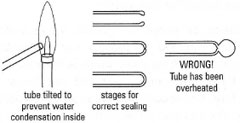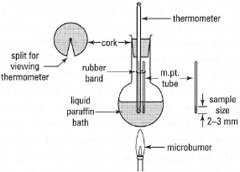Melting point apparatus
The equipment for measuring the melting point of a solid varies in complexity from a simple oil bath heated with a micro burner to a microscope with a heated stage as shown in Fig. 12.1. The essential components of a melting point apparatus are:- A sample holder: usually a glass capillary tube sealed at one end in the case of the oil bath and heated block systems, or a pair of microscope slides on an electrically heated plate in the Kofler block.
- A temperature recording device, placed as near to the sample as possible. Usually this is a thermometer but it can be a thermocouple probe with digital readout.
- A heat source with fine control to allow a gradual increase in temperature. These sources vary with the sophistication of the equipment.
 |
| Fig. 12.1 Melting point apparatus: (a) oil bath; (b) heated block - thermometer readout; (c) heated block - digital readout; (d) Kofler hot-stage microscope. |
Capillary tubes
Capillary tubes for melting point measurement are available commercially and are supplied open at both ends or closed at one end or closed at both ends. To seal one end of an open capillary tube, just touch the end of the capillary tube onto the outer 'layer' of the hot flame of a microburner (see Fig. 12.2). The end of the tube will collapse in and seal the tube. Make sure that the tube is sealed, i.e. there is not a fine line in the sealed end, and that there is no large globule of glass on the end of the tube, otherwise it may not fit into the hole in the heating block of the melting point apparatus. Similarly, if you push the tube too far into the flame, the tube will bend and therefore not fit into the heating block.
 |
| Fig. 12.2 Sealing a melting point capillary tube. |
To put the compound into the capillary tube, place a little of the dry compound in a small heap on a watch-glass and press the open end of the tube into the heap, trapping a plug of chemical in the opening. The chemical can be moved to the sealed end by turning the tube over and tapping it on the bench, or by vibrating it by rubbing it against the thread of the screw on a clamp, or dropping it down a long glass tube onto the laboratory bench. Remember: you only need 2-3 mm of sample in the bottom of the capillary tube.
Oil bath apparatus
The component parts of a typical oil bath melting point apparatus are shown in Fig. 12.3.
- Check that the mineral oil is clean and contains no water and that the bulb is only two-thirds full, to allow for expansion. Clamp the oil bath to a support stand.
- Check that your thermometer is of the appropriate range, that the mercury thread is intact and the glass, in particular the bulb, is not cracked.
- Attach the capillary to the thermometer with a rubber ring, making sure that the compound is next to the thermometer bulb and remember to hold the thermometer near the bulb while attaching the capillary tube.
- Press the thermometer into the 'notched' cork, making sure that you can see the thermometer scale, and trial fit the thermometer, sample and cork into the oil bath making sure that the thermometer bulb and sample are in the centre of the oil bath and that the rubber band is not in the oil, and will not be covered by oil, when the oil expands on heating.
- If adjustment is needed, carefully slide the cork up or down the thermometer.
- You can attach a melting point capillary to both sides of the thermometer bulb to carry out two separate melting point determinations simultaneously.
 |
| Fig. 12.3 Components of an oil bath melting point apparatus. |
Electric heated block apparatus
The heating block usually has three holes, to permit three simultaneous measurements of melting points. Always ensure that:
- The heating block is at room temperature at the outset.
- The light in the heating block works.
- The thermometer is undamaged (as above) and fits snugly into its hole in the heating block.
- All heating controls are set at zero.
- The capillary tubes slide easily into their holes in the heating block.




